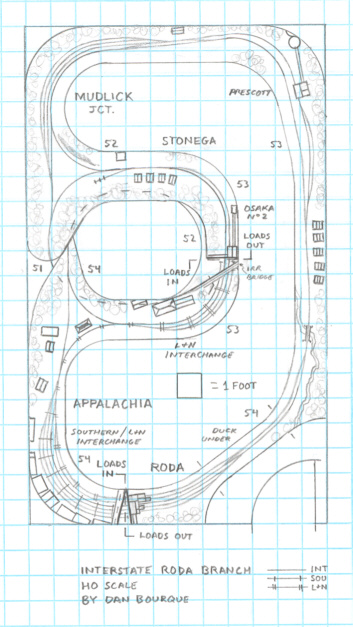- Size: 12′ x 20′
- Scale: HO
- Minimum Radius: 27″
- Minimum Aisle Width: 27″
- Designed by Dan Bourque
![]() This layout is designed for the guy who wants to be able to run mine runs without having to reset hoppers all the time. In fact, because of the two empties-in/loads-out tipples and corresponding loads-in/empties-out interchanges, mine runs can shuttle back in forth endlessly, or you can just sit back and let trains run in a circle around the layout.
This layout is designed for the guy who wants to be able to run mine runs without having to reset hoppers all the time. In fact, because of the two empties-in/loads-out tipples and corresponding loads-in/empties-out interchanges, mine runs can shuttle back in forth endlessly, or you can just sit back and let trains run in a circle around the layout.
The area near Appalachia, Virginia was a busy place for the Interstate Railroad. In Appalachia, the Interstate interchanged with both the Southern and L&N. The Interstate’s primary yard, Andover, was just a mile or so north, and further north were the coal-producing Roda and Stonega Branches. The Interstate served the Roda and Stonega Branches with a couple of mine runs daily, and yard crews were constantly shuttling cuts of hoppers back and forth from Andover to the interchanges at Appalachia.
In the late ’50s and early ’60s, the days of the brightly colored Interstate RS3s, there were only a handful of loaders on the branches. The Roda Branch was home to the newly built Prescott loader, and the old Roda tipple loaded at the end of the line. Stonega and its large banks of coke ovens had shut down, and the Osaka No. 2 tipple was the only remaining customer on the branch. Coal loaded on the Interstate went in every direction including the N&W and Clinchfield to the east, but mostly to the Southern at Appalachia with a respectable amount going to the L&N.
After the Southern’s takeover of Andover Yard in 1965, the RS3s left town in favor of Southern F-units and GPs, and a large transloader was built in Appalachia on top of the former Southern yard. The Southern interchange tracks were now used to hold cars for the transloader, and many operations on the Interstate, including Roda, were loading decrepit “yellow ball” hoppers in slave service between the mines and transloader.
The Layout
The defining feature of this layout is the empties-in/loads-out design of the Roda and Osaka tipples. The interchanges with the L&N and Southern in Appalachia provide the loads-in/empties-out areas to continuously keep the tipples supplied with loads. To keep the layout small, the yard at Andover is skipped, so the crews perform the duties of mine runs on the Roda/Stonega Branches and yard crews running interchange to Appalachia. The small yard at Mudlick Jct. is included, though, to allow the crews to do a little classification before heading to Appalachia.
The tracks in Appalachia are reduced to the minumum required for the interchange, but the feel of the town is preserved through the inclusion of the wye, station and backdrop of downtown buildings. The highway bridge south of Appalachia is moved slightly north to hide the tracks going under the backdrop. Likewise, the Interstate mainline bridge east of Appalachia is moved slightly west to hide the L&N tracks transitioning through the backdrop.
The tipple track arrangements are mostly prototypical, though the empty tracks at Osaka and Roda are obviously cut off. Osaka can easily be worked by utilizing the wye at Mudlick Jct. A short run-around at Roda has been added to allow the crew to run around empties before shoving them under the tipple. Because the layout is self-staging, there is no off-layout staging yard. An entry-level DCC system with walk-around throttle should be adequate to run this layout.
Operations
This layout could easily be operated by 1 or 2 working as a crew on the mine runs. The mine run would start in Mudlick Jct. with an RS3 and a cab. The first stop would be Appalachia to pick up empties from both L&N interchange yards and the Southern interchange yard. Back at Mudlick, the crew would block the cars for the different tipples and run up the branches with empties. Empties would be run-around and shoved under the tipple, and the loads would be pulled. At Mudlick again, the loads would be sorted for L&N and Southern, and each cut would be taken to Appalachia for interchange. Of course, upon arrival at Appalachia, more empties have miraculously appeared, and the cycle can start all over again until the crew calls it quits.
For variety, a Southern-era session could be run with most of the traffic being “yellow ball” hoppers bound for the transloader at Appalachia and a few mainline hoppers interchanged with the L&N. This could be the ever-hated F-units of the late ’60s or the GP38s of the ’70s. Of course, there could always be an L&N crew hanging around (read “blocking tracks”) to keep things interesting.
Things I Like About this Plan:
- Empties-in/loads-out for two tipples
- Continuous running loop
- Endless operation
- Two wyes in a small track plan
Things I Don’t Like About this Plan:
- Duck-under
- Limited variety
- Operations not quite prototypical
Related Products:




